With transportation taxing and spending authority set to expire on Friday night, President Obama used an auto-pen to sign the extension on a plane to Malaysia. Both chambers must agree to the bill that emerges from the conference committee by Dec. 4.
The Surface Transportation Extension Act of 2015, Part II, auto-signed on November 20, is the 36th extension since a six-year transportation bill, the Safe, Accountable, Flexible, Efficient Transportation Equity Act: A Legacy for Users (SAFETEA-LU) expired on September 30, 2009.
AASHTO Journal indicates that the bill authorizes the Highway Transportation Fund through December 4. "This is the last extension – let me put an exclamation point on that," said House Transportation Chairman Bill Shuster (R-Pa.).
The House-Senate Conference Committee, convened after the House passed their six-year transportation reauthorization bill on November 5, will now need to complete its negotiations over differences between the House- and Senate-passed DRIVE Act, present it to both chambers which must agree on a final version before the extension expires—not leaving much leeway.
If the conference committee's schedule slips as members negotiate, the panel would need to file a final report no later than Dec. 2 to avoid yet another extension past Dec. 4. House procedures require that members have 48 hours to view legislation before voting on it.
Funding
While the final bill will be the first six-year transportation since 2005, it will only have funding for three years.
"The Congressional Budget Office has estimated it will take about $100 billion, in addition to the annual gas tax revenue, to pay for a six-year transportation funding bill," writes Keith Laing in his article on the auto-signing of the transportation extension.
FULL STORY: Negotiators Plan ‘Ambitious Schedule’ to Unveil Surface Transportation Bill Nov. 30

Alabama: Trump Terminates Settlements for Black Communities Harmed By Raw Sewage
Trump deemed the landmark civil rights agreement “illegal DEI and environmental justice policy.”

Study: Maui’s Plan to Convert Vacation Rentals to Long-Term Housing Could Cause Nearly $1 Billion Economic Loss
The plan would reduce visitor accommodation by 25% resulting in 1,900 jobs lost.

Why Should We Subsidize Public Transportation?
Many public transit agencies face financial stress due to rising costs, declining fare revenue, and declining subsidies. Transit advocates must provide a strong business case for increasing public transit funding.

Paris Bike Boom Leads to Steep Drop in Air Pollution
The French city’s air quality has improved dramatically in the past 20 years, coinciding with a growth in cycling.

Why Housing Costs More to Build in California Than in Texas
Hard costs like labor and materials combined with ‘soft’ costs such as permitting make building in the San Francisco Bay Area almost three times as costly as in Texas cities.

San Diego County Sees a Rise in Urban Coyotes
San Diego County experiences a rise in urban coyotes, as sightings become prevalent throughout its urban neighbourhoods and surrounding areas.
Urban Design for Planners 1: Software Tools
This six-course series explores essential urban design concepts using open source software and equips planners with the tools they need to participate fully in the urban design process.
Planning for Universal Design
Learn the tools for implementing Universal Design in planning regulations.
Smith Gee Studio
Alamo Area Metropolitan Planning Organization
City of Santa Clarita
Institute for Housing and Urban Development Studies (IHS)
City of Grandview
Harvard GSD Executive Education
Toledo-Lucas County Plan Commissions
Salt Lake City
NYU Wagner Graduate School of Public Service



























